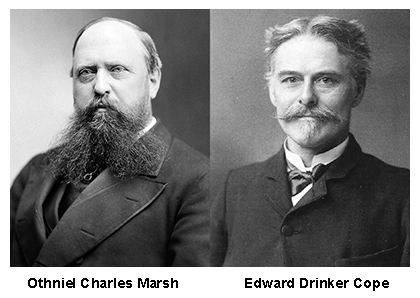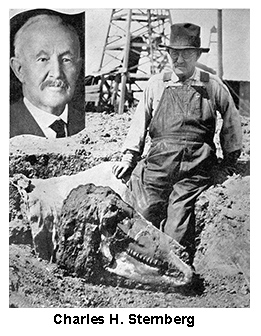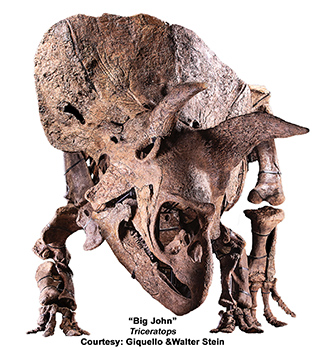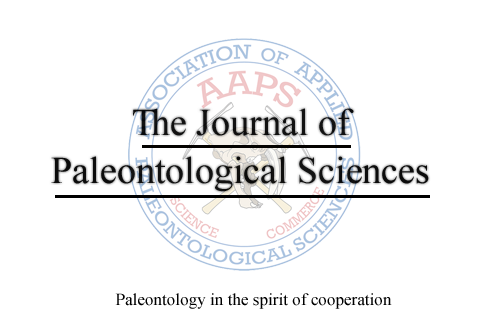"The New Bone Wars"
by George F. Winters
 The term, Bone Wars was first penned to describe what was going on in the field and research offices of academic paleontology in the United States during the later portion of the 19th century. Two well-known paleontologists, Professors Othniel Charles Marsh and Edward Drinker Cope were literally feuding in western North America in a battle to collect the most exciting fossil specimens while racing to name new species of dinosaurs, mammals, and reptiles. It was this rivalry between these two men of science that sparked the bone wars. As the science of paleontology and more specifically vertebrate paleontology evolved in the United States, more institutions were created, major museums opened their doors around the country and of course the number of academic paleontologists grew. The term, Bone Wars was first penned to describe what was going on in the field and research offices of academic paleontology in the United States during the later portion of the 19th century. Two well-known paleontologists, Professors Othniel Charles Marsh and Edward Drinker Cope were literally feuding in western North America in a battle to collect the most exciting fossil specimens while racing to name new species of dinosaurs, mammals, and reptiles. It was this rivalry between these two men of science that sparked the bone wars. As the science of paleontology and more specifically vertebrate paleontology evolved in the United States, more institutions were created, major museums opened their doors around the country and of course the number of academic paleontologists grew.
 Throughout the 20th century the number of professional or commercial paleontologists expanded. Once limited to Charles H. Sternberg and his family and a few other individuals such as Robert Lee Craig in Kemmerer Wyoming. Rock shops that sold local fossil specimens were a common sight along many state roads and highways before the major interstate highway system was built. Many academic paleontologists of the time visited these local shops and purchased specimens. Throughout the 20th century the number of professional or commercial paleontologists expanded. Once limited to Charles H. Sternberg and his family and a few other individuals such as Robert Lee Craig in Kemmerer Wyoming. Rock shops that sold local fossil specimens were a common sight along many state roads and highways before the major interstate highway system was built. Many academic paleontologists of the time visited these local shops and purchased specimens.
The Society of Vertebrate Paleontology (SVP) was formed in the 1940s, created by academic paleontologists of the time such as George Simpson, Al Romer and Edwin Colbert, to bring together people from all walks of life who loved and worked in the field of fossil vertebrates. Even students and commercial (professional) paleontologists were offered memberships in the SVP. These founders and early members recognized commercial paleontologists as a necessity in field for their exploration and preparation skills and were grateful for the contributions these individuals and companies made.
By the mid 1950's a new breed of pioneers in the field, such as A. Allen Graffham, started collecting and selling fossils. His company, Geological Enterprises (GE) sold a wide variety of fossils (but primarily invertebrates) to universities, high schools, as well as individuals. He donated many newly discovered species and like the Sternberg's, worked closely with paleontologists and as a result was respected by many academics.
In the 1970's, companies like Black Hills Institute of Geological Research (BHI) opened their doors and soon became well known for dinosaurs, mammals, ammonites and other fossil discoveries as well as their innovative abilities in fossil preparation. While many of their best specimens went to American and international institutions, they also sold common specimens to collectors at fossil and mineral shows of the time.
Things started to change in the mid to late 1980s. There were a small but vocal group of members of the Society of Vertebrate Paleontolgy that were not happy or were jealous with the commercial aspect of vertebrate paleontology and started to let their feelings known at the society's annual meetings. They began to view fossils as almost "sacred objects" and didn't want anyone else (besides themselves) to be able to collect or work with fossils and decided to make their feelings well-known. At the same time, many academic paleontologists such as Robert Bakker, Ken Carpenter, Phil Currie, and others realized the importance and benefit of collaboration with professional paleontologists in the field, such as Black Hills Institute and Geological Enterprises.
This resulted with a strong anti-commercial and anti-private ownership of "important" fossil specimen clause being added to the society's bylaws and an ethics clause that include, "The barter, sale, or purchase of scientifically significant vertebrate fossils is not condoned unless it brings them into, or keeps them within, a public trust. Any other trade or commerce in scientifically significant vertebrate fossils is inconsistent with the foregoing, in that it deprives both the public and professionals of important specimens, which are part of our natural heritage." New members were expected to agree to this clause. The vertebrate paleontologists that formulated this bylaw and fought to implement it, believed that unless a "important specimen" is given to a "registered repository", it should not be studied and considered "lost to Science". While this was an opinion, it is not a fact. The specimens still exist, and they still can help with answering many questions in the science of paleontology.
Certain members of the SVP chose not to study such specimens, even though accommodations could easily be made to allow scientists to either purchase or be allowed access to specimens in private collections. It should be noted that many other scientific groups such as the "Paleontological Society" in the United States continue to allow for the research of privately owned specimens. Many invertebrate specimens in private collections have been the subject and topic of research papers and books in the United States and such research is often revisited in succeeding papers on the subjects.
 In Europe, many specimens in private collections have been and are continued to be studied and published upon. A prime example is the primate, Darwinius massillae, from the Eocene of Messel in Germany, the paper was published in 2010. An acceptable system to research privately owned specimens can be created if a consensus is met among academic, professional (commercial) and private collectors. Many specimens discovered on private property by landowners or professional paleontologists with access to the private land are often only offered to museums and research facilities. Case in point, Big John the Triceratops horridus pictured to the right. Discovered by Walter Stein in 2014, who with friends and colleagues collected the specimen. Stein had the specimen in field jackets for nearly 6 years. The specimen was widely advertised, seen at shows, on social media, on the PaleoAdventures website; it was not a secret. Even so, not a single academic ever made an inquiry or offered to buy the skeleton. Stein would have been happy to work with any museum and would have bent over backwards to get it into a Museum in the USA. Once he sold the specimen and preparation was completed, it was mounted by Italian team at Zoic Inc, who did a spectacular job. It then sold at auction in Paris for more than 6.4 million dollars. In Europe, many specimens in private collections have been and are continued to be studied and published upon. A prime example is the primate, Darwinius massillae, from the Eocene of Messel in Germany, the paper was published in 2010. An acceptable system to research privately owned specimens can be created if a consensus is met among academic, professional (commercial) and private collectors. Many specimens discovered on private property by landowners or professional paleontologists with access to the private land are often only offered to museums and research facilities. Case in point, Big John the Triceratops horridus pictured to the right. Discovered by Walter Stein in 2014, who with friends and colleagues collected the specimen. Stein had the specimen in field jackets for nearly 6 years. The specimen was widely advertised, seen at shows, on social media, on the PaleoAdventures website; it was not a secret. Even so, not a single academic ever made an inquiry or offered to buy the skeleton. Stein would have been happy to work with any museum and would have bent over backwards to get it into a Museum in the USA. Once he sold the specimen and preparation was completed, it was mounted by Italian team at Zoic Inc, who did a spectacular job. It then sold at auction in Paris for more than 6.4 million dollars.
The outcry from the academic world began and articles condemning the sale were prominent on hundreds of websites. Only after hundreds of thousands of dollars had been invested in the skeleton resulting in a sale for millions of dollars did the scientific community finally pay attention to this specimen. This outcry was similar to the outcry for the sale of Sue the Tyrannosaurs rex many years ago, and the nearly two dozen other dinosaur specimens sold in auction over the last three decades. The sale of Sue and several other specimens proves that museums can find the funding to purchase these specimens when they want.
The reality is that professional collectors and dealers have sold or donated thousands of vertebrate, invertebrate, plant and trace fossils to museums and institutions around the world including many type specimens that have been published. Visit the AAPS Journal webpage: https://aaps-journal.org/Commercial-Contributions-to-Paleontology.html to view the ever-growing list of specimens now in public repositories that demonstrates cooperation is beneficial to science.
Until the academic community and the commercial dealers learn to speak a "common language" in America, there will always be harsh differences of opinion and hard feelings on both sides. If only academic, professional, and private collectors could adopt a new spirit of cooperation, we could finally put an end to the "The New Bone Wars".
The Association of Applied Paleontological Sciences has always collectively felt that "a fossil not collected is a fossil not protected". If you agree that there needs to be a better relationship between academic and professional paleontologists and wish to support the full study of all important paleontological specimens, please join us, https://www.aaps.net/pdf/membership-application.pdf
|

